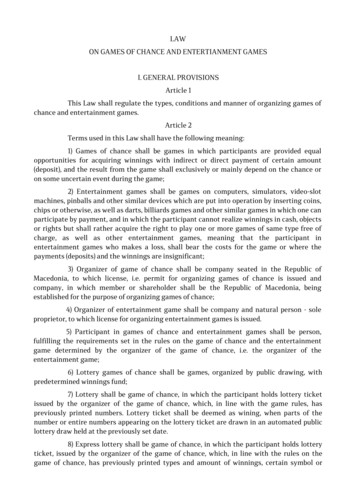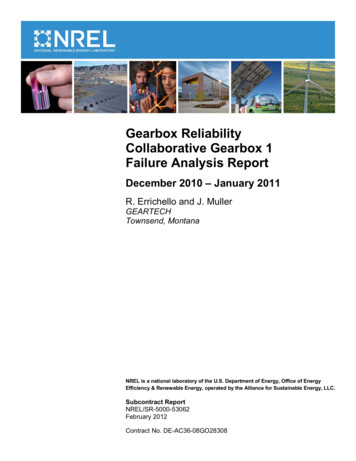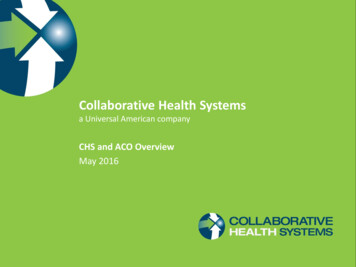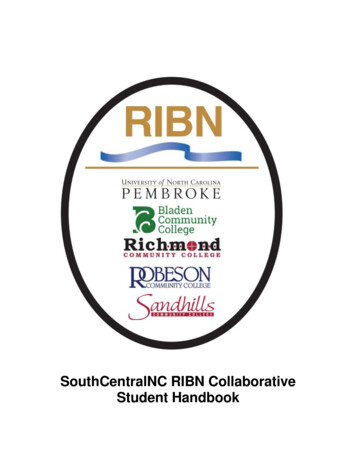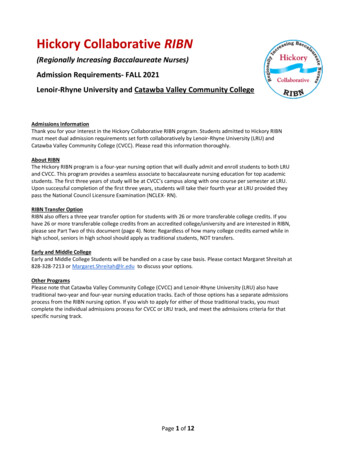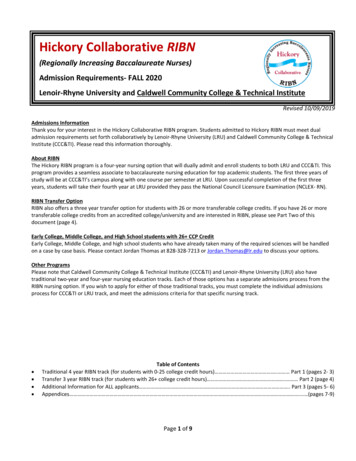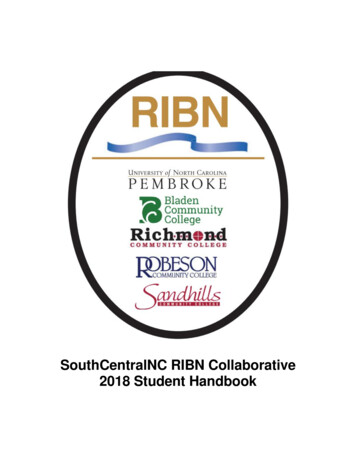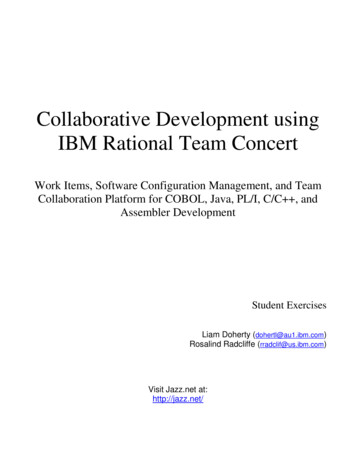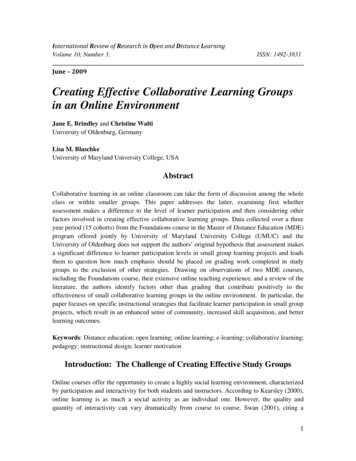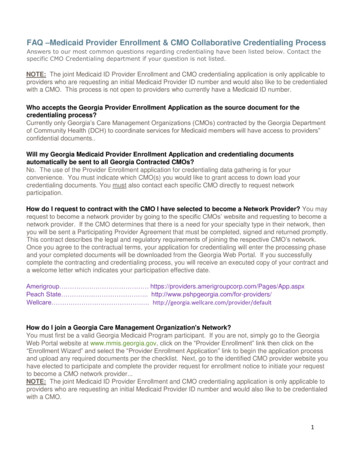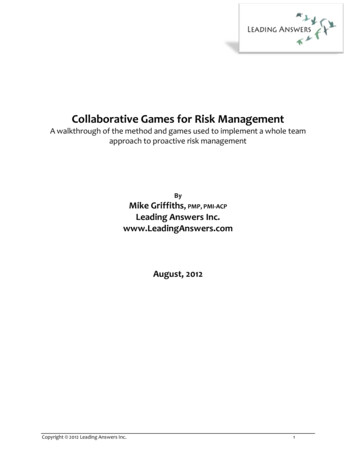
Transcription
Collaborative Games for Risk ManagementA walkthrough of the method and games used to implement a whole teamapproach to proactive risk managementByMike Griffiths, PMP, PMI-ACPLeading Answers Inc.www.LeadingAnswers.comAugust, 2012Copyright 2012 Leading Answers Inc.1
ContentsIntroduction . 3The Agile Advantage towards Risk Management . 4The Benefits of Collaboration . 5A Risk Management Framework. 61. Plan Your Trip - (Plan Risk Management) . 72. Find Friends and Foes – (Risk and Opportunity Identification). 93. Post Your Ad – (Qualitative Risk Analysis) . 124. Today’s Forecast -- Quantitative Risk Analysis . 145. Backlog Injector -- Plan Risk Responses . 166. Risk Radar -- Monitoring and Controlling Risks . 19Conclusion . 20Copyright 2012 Leading Answers Inc.2
IntroductionRisks and opportunities are ever present on complex projects. We can rely on them occurring muchlike we can rely on the tide coming in. How we choose to deal with them, our risk managementstrategy, greatly influences whether we rise with the inevitable tide of issues and navigatesuccessfully, or be overwhelmed by them and not reach our goal.Agile methods incorporate many mechanisms for dealing with late breaking changes (an easilyreprioritized backlog, short iterations, frequent inspection and replanning, etc) that also lendthemselves to proactively responding to risks. We can insert risk avoidance and risk reduction actionsinto the backlog to proactively attack the risks before they have an impact on the project.This can all be thought of as part of maximizing business value. The process of frequently asking:“What should we do next; build a business feature, or reduce a project risk?” is valuable and oftensummarized by the term “The next best dollar spent”, it reminds us to think about risk avoidance andmitigation as part of the value proposition and agile planning cycle.So, when planning work for the next iteration we balance delivering business value with reducingrisks. Sometimes we select a feature since it is the best return on our investment. Sometimes we willundertake a risk avoidance or risk mitigation step since the impact of the risk occurring would begreater than the ROI value of the next feature in the backlog.Over the course of the project, agile teams use tools such as risk burn down graphs and risk profilesto illustrate the effectiveness of the risk-driven approach. The goal is to rapidly reduce risks on theproject.Another benefit of tackling risky work early is the cost of change curve savings possible in softwareprojects. By proactively undertaking risky work early we can reduce the overall impact to the projectcompared to if those risks occurred later when their effect in terms of rework or revision ofapproach would be much higher. Simply put, risks solved early are more valuable than risks solvedlate.Copyright 2012 Leading Answers Inc.3
The Agile Advantage towards Risk ManagementAgile methods with their pull mechanisms and frequent reprioritisation can readily take riskmanagement actions as early as possible in the lifecycle, minimizing knock-on effects. Also, sincetesting is built into each iteration towards the end of the project the chances of there being any riskyelements not tested in the solution are greatly reduced. As such, agile methods can be called “riskdriven”, since we are always looking to pull stories with risks forward in the backlog.While agile methods provide some nice ways to proactively embrace good risk managementpractices, they do not risk-proof or insulate projects from risks. Indeed, if the agile approach is newto your organization then its introduction will be a risk itself – anything new represents a risk ofmisapplication, misunderstanding, confusion and failure. However, agile methods are hardly newanymore and adoption problems are well understood.We want to overcome many of the correct-but-not-sufficient aspects of risk management seen toooften on projects:Poor engagement - dry, boring, academic, done by PM, does not drive enough changeDone once – typically near the start, when we know least about the projectNot revisited enough – often “parked” off to one side and not reviewed againNot integrated into project lifecycle – poor tools for task integrationNot engaging, poor visibility – few stakeholders regularly review the project risksLet’s explore extending risk management beyond the project manager role and investigate thebenefits of making it more of a collaborative team exercise.First of all, why collaborative team games? Just as techniques like Planning Poker and IterationPlanning effectively make estimation and scheduling a team activity and gain the technical insights ofengaging people closer to the work. So too do collaborative games for risk management; after all,why leave risk management to the person who is furthest from the technical work – the projectmanager?Before I upset project managers worried about erosion of responsibilities we need to be clear onwhat the scope is here. I am advocating the closer and more effective engagement of the teammembers who have insights into technical and team related risks. I am not suggesting we throw therisk register to the team and tell them to get on with it. Instead we are looking for better quality riskidentification and additional insights into risk avoidance and mitigation, not the wholesaledisplacement of the risk management function.So why should we bother to engage the team? Why not let them get on with doing what they aresupposed to be doing, namely building the solution? Well there are some reoccurring problems withhow risk management is attempted on projects. Most software projects resemble problem solvingexercises more than plan execution exercises. It is very difficult to separate out the experimentationand risk mitigation form the pure execution. Team members are actively engaged in riskmanagement every day. We can benefit from their input in the risk management process and if theyare more aware of the project risks (by being engaged in determining them) how they approachtheir work can be more risk aware and successful.Copyright 2012 Leading Answers Inc.4
The Benefits of CollaborationThe benefits of collaboration are widely acknowledged, a study by Steven Yaffee from the Universityof Michigan cites the following benefits:1.2.3.4.5.Generates wiser decisions through the understanding of complex, cross boundary problemsvia shared informationPromotes problem solving rather than procedural decision makingFosters action by mobilizing shared resources to get work doneBuilds social capital by building relationships and understandingFosters ownership of collective problems by valuing participation and shifting powerdownwardsThere are some powerful concepts here that are worth a second look. It is pretty obvious thatengaging a larger group of stakeholders will produce a better list of possible risks and then yieldmore creative ways of avoiding or reducing those risks. However the real benefits of engaging theteam come from the changes that happen in the team.By engaging the team not only do we get better input data and ideas, but we also encourageproblem solving, foster action, build social capital and foster collective ownership of ideas. No longerdo we have a single project manager worried about the risks, we now have a motivated, energizedand empowered team proactively managing the risks.Far too often projects do a great job at indentifying possible risks and a lousy job doing anythingabout them. The result is projects that get derailed when a known risks becomes an issue. When theteam is fully plugged into the project risks, small changes in their behaviour eliminate many risks attheir source, long before they get large enough to threaten the project.Finally the last point in Yaffee’s benefits of collaboration list is noteworthy too. Valuing participationand shifting power downwards fits extremely well with the empowered teams and servantleadership model promoted by agile methods. We already encourage these ideas in reportingprogress via daily stand-ups, estimating via planning poker, and decision making via fist of fivetechniques, so why not in risk management?Of course collaboration is no silver bullet. Like all good approaches there are downsides andpotential for misuse. Brainstorming for example can actually stifle innovation and lead to groupthink.The New Yorker magazine [1] describes numerous studies that show how brainstorming groups thinkof fewer, lower quality, ideas than the same number of people who work alone and later pool theirideas. So, let’s be clear, collaboration, does not only mean brainstorming, it also includes poolingindividual ideas and group validation.Copyright 2012 Leading Answers Inc.5
A Risk Management FrameworkThe PMI’s latest guidance on risk management comes from the PMBOK v5 Guide Exposure Draft, itdescribes a six step process for risk management:1.2.3.4.5.6.Plan Risk ManagementIdentify RisksPerform Qualitative Risk AnalysisPerform Quantitative Risk AnalysisPlan Risk ResponsesControl RisksThrough collaborative games each of these 6 risk management steps can be recreated as highlyvisual, team based activities that then create risk avoidance and risk mitigation stories for theproduct backlog.We want visual collaborative games because visual representation helps engage the left and righthemi-spheres of the brain. They allow us to tap into our spatial awareness and memory to avoidforgetting about risks. This is the reason today’s military still use visual tokens to represented enemyforces, despite having access to the world’s most sophisticated tools. The impacts of forgettingabout them can be fatal. The same goes for project risks.The collaborative games that cover these steps are:1) Plan Your Trip – (Plan Risk Management)a. 4Cs - Consider the Costs, Consequences, Context and Choicesb. Are we buying a Coffee, Couch, Car, or a Condo? How much rigor is appropriate andwhat is the best approach?c. Deposits and Bank Fees – understanding features and risks2) Find Friends and Foes – (Risk and Opportunity Identification)a. Doomsday clock,b. Karma-dayc. Other risk identification forms (risk profiles, project risk lists, retrospectives, userstory analysis, Waltzing with Bears - Top 5-10 for software)3) Post Your Ad – (Qualitative Risk Analysis)a. Investors and Help Wanted – classification and visualization of opportunities andrisksb. Tug of War – project categorization4) Today’s Forecast - (Quantitative Risk Analysis)a. Dragons Den – next best dollar spentb. Battle Bots - simulations5) Backlog Injector – (Plan Risk Responses)a.b.c.d.Junction Function – choose the risk response pathDollar Balance – Risk / Opportunity EVM to ROI comparisonReport Card - Customer/Product owner engagementInoculator – inject risk avoidance/mitigation and opportunity stories into backlog6) Risk Radar – (Monitoring and Control Risks)a. Risk Burn Down Graphs - Tracking and monitoringCopyright 2012 Leading Answers Inc.6
b. Risk Retrospectives - Evaluating the effectiveness of the risk management planc. Rinse and Repeat - Updating risk management artifacts, revisiting process1. Plan Your Trip - (Plan Risk Management)This phase is about deciding and defining how to conduct risk management activities for the project.We want to tailor the process to ensure that the degree, type, and visibility of risk management iscommensurate with both the risks and the importance of the project to the organization. So we donot use a sledgehammer to crack a nut, or undertake a risky, critical endeavor with an inadequateprocess.The other goal we have for this phase is to teach some risk basics to the team since they may not befamiliar with the concepts or terminology.The name of the first exercise “Plan your trip” speaks to the goal of determining the appropriatelevel of rigor. Most people can associate with planning for a walk or hike and this is the context weuse for the activity called the 4Cs. Early in any collaborative workshop I like to get people working. Ifyou let them spectate for too long some will retreat into “observer” rather than “participator”mode.Working individually (again to encourage active engagement, and avoid groupthink) ask the team toconsider what they would pack for a 2 mile hike in the country on a warm day. Give them a couple ofminutes to create lists on Post-it notes and review their responses as a group. Some will suggesttaking nothing, or just a bottle of water, others rain jackets, bear spray (I live near the RockyMountains in Canada) and all sorts of other things. We then review the pros and cons of these items.They are useful if you need them, but a burden to carry. We then repeat the exercise changing someparameters such as making it a 10 mile hike, or multi day trip, in the mountains, in the winter time.Now the lists get longer as people prepare for more eventualities.For each situation we review the 4Cs, the Costs, Consequences, Context and Choices. What we bring(and how we prepare for risk management) varies based on the Cost of bringing/using it, theConsequence of not having it (rain coat - get wet, warm jacket – cold/hypothermia). We also examinethe Context we are talking about, preparations for elite ultra-marathoners who are hardy, capable,and resourceful or a kids’ group who need more protection. Finally, the Choices we make, should bean informed balance of Cost vs Consequence in the frame of the Context.We need to understand these same elements in planning our risk management approach too. Is thisproject domain our core competency? What are the costs and consequences of project risksoccurring, what is our company’s risk tolerance and preferred risk management approach? Makesure people understand the environment.Another tool to relate the need to tailor the process appropriately is to ask the team to consider thedecision rigor they put into their purchases. They way we consider buying a Coffee ( 2), a Couch( 2,000), a Car ( 20,000), or a Condo ( 200,000) vary as the figures involved escalate.For a coffee, we probably just find something close, maybe at our favorite coffee-brand store. For acouch people will shop around and likely buy the one they like the best without much furtherCopyright 2012 Leading Answers Inc.7
research. When it gets up to car territory, safety, economy and resale factors are routinely examined.For a condo purchase the stakes are so high that most people engage professional help from homeinspectors and condo document review companies. We need to do the same for our projects, askingwhat is appropriate for the endeavor.Finally, if the team is new to risk management then a discussion on trade off between business valueand risks might be necessary. We undertake projects usually for the potential upside (or forcompliance projects to avoid the downside) we are hoping for business benefits. Agile projects usebusiness value as an input into work prioritization; we do the high value items first. We want todeliver business value. Getting business value out of a project is like receiving deposits into our bankaccount; e want them as often as possible, and preferably as large as possible. Given the uncertaintyin the world, we want the biggest gains as soon as possible, before anything changes that maythreaten future deposits.In this bank analogy risks are like withdrawals; or bank fees, should they occur they set the projectback, take away resources from delivering business value, and threaten the delivery of future value.So to get the most out of a project we need to maximize business value while avoiding or reducingrisks.These exercises and discussions aim to get the team thinking about the appropriate level of riskmanagement for the project and gain consensus and support for the strategy that is agreed upon.Without this shared understanding of “Why?” we will not get people invested in the process.Copyright 2012 Leading Answers Inc.8
2. Find Friends and Foes – (Risk and Opportunity Identification)The next step in the process is to identify potential risks and opportunities. Opportunities are the“good” risks or fortuitous events that have a positive impact should they occur. We want to avoidrisks and exploit opportunities.The IEEE have some good risk profile models for software projects. They were created by collectingrisk information from thousands of completed software projects, then categorizing and ranking thecommon ones. These models can be used in a group setting, or as I prefer, used as the inspiration fora collaborative game.Using a clock view pre-drawn on a white board or flip chart we ask team members to think of projectrisks associated with each of the topics represented by an hour line on the clock – 12 in total.This is the doomsday part, we encourage the team members to think of and record as many risks asthey can about that topic. We work topic by topic, but if thinking of risks triggers ideas in other areasas we progress, it is not unusual to get risks being added to previously discussed risk lines. Again, Iprefer having people working individually for coming up with ideas. Then we put them all on the walland consolidate and remove duplicates as a group, which also sometimes identifies new risks.This process takes a while, spending just 5 minutes on each topic requires an hour to go throughthem. Discourage people’s tendencies to want to score, rank and solve the risks. This is riskidentification, we will have plenty of time to process them later.Copyright 2012 Leading Answers Inc.9
A wall filled with risk stickies around every aspect of the project can seem like a discouragingprospect for some, but it is also a useful eye opener for why risk management is so important. Thisproject is not magically going to work out all by itself. We have some real obstacles in front of us andwe need to work as a team to avoid and reduce them.Always within the same session, I like to run the flip side exercise – “Karma Day”. In this exercise wegenerate opportunities for events and outcomes that would assist the project. Generating ideas forthings that would help the project go well. Using the same clock metaphor we come up with lists ofall the good things that could occur to assist the project.Cynical team members may still continue to gripe, suggesting opportunities “inverted issues” such as“Actually getting 1-2 day turn around on our database requests, for a change” or “support notresistance from the PMO”, but these can be really useful. Just as we later ask in risk management“How do we avoid or reduce these risks” in opportunity management we ask “How do we ensure ormaximize these opportunities?” If spending a couple of hours explaining the project goals andCopyright 2012 Leading Answers Inc.10
approach
6. Control Risks Through collaborative games each of these 6 risk management steps can be recreated as highly visual, team based activities that then create risk avoidance and risk mitigation stories for the product backlog. We want visual collaborative games because visual representation h
